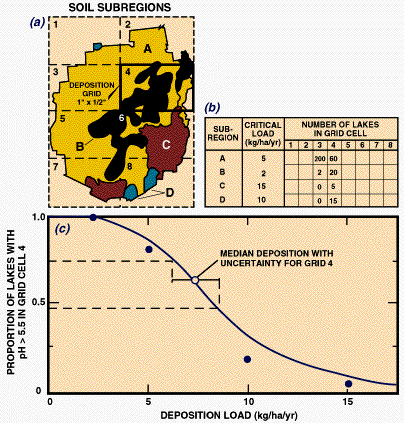


Two approaches for presenting resources at risk to policymakers. (a)
Map showing relationship between deposition grids and subregions. (b) Table of critical loads
and number of lakes by subregion. (c) Pollutant dose and ecosystem response
curve.

What is the feasibility of an effects-based (critical loads) approach to atmospheric pollutant regulation and abatement?

A critical load is the amount of pollutant that sensitive ecosystems can be exposed to on a sustained basis without experiencing measurable degradation.
Researchers proposed a six-step approach for setting critical loads: (1) selection of ecosystem components, indicators, and characterization of the resource; (2) definition of functional subregions; (3) characterization of deposition within each of the subregions; (4) definition of an assessment endpoint; (5) selection and application of models; and (6) mapping of projected ecosystem responses. This approach has much in common with ecological risk assessment. Variability in ecosystem characteristics and data and model uncertainty were recognized as integral parts of the assessment process. The need for intercomparison activities among data and model options was stressed.

Hunsaker, C. T., R. Graham, R. S. Turner, P. L. Ringold, G. R. Holdren, and T. C. Strickland. 1993. A national critical loads framework for atmospheric deposition effects assessment: II. Defining assessment end points, indicators, and functional subregions. Environmental Management 17(3):335-341.
Holdren, G. R., T. C. Strickland, B. J. Cosby, D. Marmorek, D. Bernard, R. Santore, C. T. Driscoll, L. Pardo, C. Hunsaker, and R. S. Turner. 1993. A national critical loads framework for atmospheric deposition effects assessment: IV. Model selection, applications, and critical loads mapping. Environmental Management 17(3):255-363.
Hunsaker, C. T., and R. L. Graham. 1991. Regional ecological assessment for air pollution. pp. 313-334. In S. K. Majumdar, E. W. Miller, and J. Cahir (eds). Air Pollution: Environmental Issues and Health Effects. The Pennsylvania Academy of Science, Easton, Pa.
Integrated Assessment Briefs. 1995. ORNL/M-4227. Oak Ridge National Laboratory, Oak Ridge, TN.